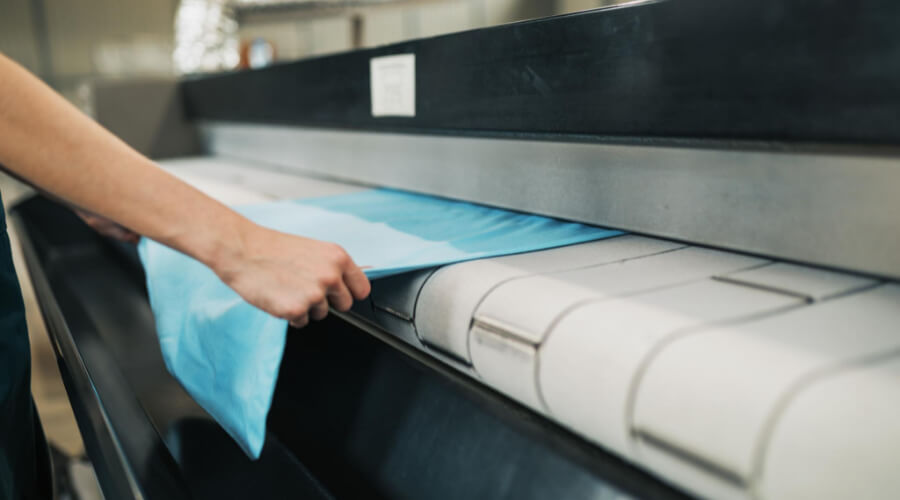Last Updated on July 23, 2023 By Emma W. Thomas
You can take your clothes to the drycleaners the way you want. For example, you can take them on hangers if you want to point out some areas like damage, stains, or ornamentation. You can also separate your clothes into piles like pants, shirts, whites, or colored ones and drop them off at the front counter.
How To Take Clothes To Dry Cleaners
Taking your clothes to the dry cleaners can often be a time-saving and hassle-free solution to keep your garments looking their best. However, proper preparation and understanding of the process are vital to ensure the best results. To help you make the most of your visit to the dry cleaners, here are seven essential tips that you should keep in mind.
- Sort and separate:
Begin by sorting your clothes according to color and fabric type. Separate lights from darks to avoid color bleeding, and group delicate fabrics separately to ensure gentle care. This step will help the dry cleaners to treat your clothes appropriately and minimize the risk of any damage. - Check for stains:
Before taking your clothes to the dry cleaners, inspect them thoroughly for stains. Make a mental note or mark the stains with pins or clips, ensuring that the dry cleaner is aware and can focus on the problem areas. Providing as much detail as possible will enhance the chances of successful stain removal. - Read care labels:
Take a moment to read and understand the care instructions on your garments. Each item may have specific recommendations that the dry cleaners should follow. By communicating this information to the professionals, you can ensure that your clothes receive the appropriate cleaning and care. - Remove items from pockets:
Always empty the pockets of your clothes before dropping them off at the cleaners. Remove any loose change, receipts, or other small items that could potentially damage the garments or interfere with the cleaning process. This step will minimize the risk of accidental loss or damage to your belongings. - Secure loose buttons and repairs:
Inspect your clothes for any loose buttons, tears, or damages that need attention. Sewing loose buttons and repairing minor damages before taking them to the dry cleaners will help maintain the integrity of your garments. By addressing these issues beforehand, you can guarantee that the dry cleaners will handle your clothes with care. - Communicate your preferences:
Clearly communicate your preferences to the dry cleaners. If you have any concerns regarding the cleaning process or special instructions for specific items, make sure to convey them beforehand. This will help the dry cleaners understand your requirements, ensuring maximum customer satisfaction. - Choose a reliable dry cleaner:
Last but certainly not least, selecting a reliable and reputable dry cleaner is crucial. Seek recommendations from friends or family, review online testimonials, and consider factors such as expertise, customer service, and convenience. A good dry cleaner will ensure the safe and optimal cleaning of your garments.
How Do You Know Which Garments To Take To Dry Cleaners?

Before
Ensure that you check if the fabric is colorfast by dabbing a little water on a hidden spot. If no dye comes out, then you can safely clean at home. On the other hand, if you notice some coloring coming off, take the garment for dry cleaning. Washing the cloth at home may damage it, and its color is likely to run.
If you have lined clothes such as coats or jackets, pleated skirts, or other fabrics that shrink or are not colorfast, take them for professional cleaning. Professional cleaning helps to maintain the right fit and shape of your garments. For garments made of silk, velvet, taffeta, wool, and fabric blends that include wool, rayon, and silk, make sure that an expert dry-cleans them unless the care label instructs otherwise.
If your clothes are made of leather or suede, they must also be dry-cleaned since home care may damage their textures, unique fiber, and shape.
How Do You Prepare Clothes For Dry Cleaning?
Make sure that you remove everything from the pockets, for example, makeup and gum, to prevent damaging the clothes when cleaning. Place tape or pins near stains to make them easy to find. If you know the stain’s origin, make a list indicating the same to help the person cleaning decide on the best removal method.
Check for any damages on your clothes, such as broken zippers, loose buttons & threads. Make sure that you mention these issues to the dry cleaning expert and tell them the specific service you want.
When transporting your clothes to the dry cleaners, ensure that the delicate items are not in contact with direct sunlight. Since prolonged exposure to sunlight can weaken your clothes’ fibers, put your garments in protective bags during their transportation.
Which Fabrics Need To Be Dry-cleaned?

Some fabrics can be hand-washed, machine-washed, or dry-cleaned. It is necessary to know which of your garments are appropriate for dry cleaning and which ones are not. The following table gives a summary of these garments.
Fabric | Reasons For Dry Cleaning |
Silk | To retain its color and protect it from damage. |
Suede | To maintain the fabric and give it proper care |
Wool | It prevents shrinking and makes it more durable. |
Linen | Protects the quality from deteriorating |
Leather | Helps to remove stubborn stains like oil and ink |
Rayon | Prevents shrinking and helps maintain its shape |
Silk
Silk fabrics have natural fibers that are strong and which do not absorb dyes completely. If you wash the clothes with water and soap, it will cause them to shrink, lose color, and get distorted. Dry-cleaning silk garments will help protect them from damage and ensure that their colors remain vibrant.
Suede
Suede fabrics are made from a special kind of leather from goat and cowhide and lambskin. This material is challenging to maintain since it is prone to moisture, light, chemical-based, and water-based cleaners. To properly maintain and care for suede fabrics, you need to hire the services of a dry cleaning expert who uses non-toxic chemicals.
Wool
Hand-washing wool fabrics or dipping them in water will cause them to shrink. To avoid this problem and make your garments last longer, it is necessary to dry-clean them.
Linen
Linen is an absorbent, strong material that is derived from flax. This material dries faster than cotton, and it can be hand-washed and air-dried. But, it needs frequent ironing to keep the flax fibers in good condition. Improper handling will make linen fabrics lose their crispness and deteriorate their overall quality. It is, therefore, advisable to have linen garments dry cleaned.
Leather
Leather fabrics come with special care instructions. Since these garments are exceptionally delicate, you need to follow the instructions explicitly and ensure that dry cleaning is only for removing oil spills and ink blemishes.
Rayon
Rayon is a semi-synthetic fabric that is made from purified cellulose fibers. Washing rayon with warm water can cause it to bleed due to the dyes in the fibers causing it to shrink and lose shape. Rayon garments will be okay if you use mild detergents and cold water, but dry cleaning is better.
How Do You Pack Your Dry-cleaned Clothes?
It is essential to pack your dry-cleaned clothes carefully to keep them wrinkle-free. Below are some ways to prevent wrinkles;
Packing Your Clothes Loosely
Squeezing a lot of garments together results in their getting wrinkled. It is essential to pack them as loosely as possible in the suitcase or bag to prevent such problems. Make sure that you do not also leave a lot of space between the clothes, as making the garments shift around. Leave behind any bulky items such as hair dryers when traveling since you will get them in most hotel rooms.
Folding The Clothes Carefully
Some garments such as dresses, sweaters, and dress shirts will stay wrinkle-free when you fold them. You need to fold them carefully and lay them flat on your suitcase’s bottom. Make sure that you fold over the sleeves but, don’t fold over the shoulders on jackets or blazers. Follow the natural seams on each garment while folding for a good outcome and avoid tight squares as this could result in wrinkled clothes.
Rolling Your Garments
Rolling your clothes helps prevent wrinkles and also maximizes the space in your suitcase. This method is suitable for jeans, shorts, and T-shirts. First, fold the clothes lengthwise, then roll them from the bottom to the top. Make sure that you line up the pieces loosely in the suitcase and do not put any heavy items on top.
Using A Plastic Bag
When packing delicate items, you can use plastic dry-cleaning bags. These bags help to prevent wrinkles by minimizing friction between your garments. You can put the items inside the plastic bags and place them flat at your suitcase’s bottom, which will prevent them from shifting around.
What Does Dry Cleaning Involve?
Dry cleaning is the process of cleaning fabrics using a chemical solvent with little or no water. The process cleans the fabric’s surface without penetrating the fibers, unlike when washing with a machine. This process protects garments from stretching or shrinking, therefore preserving their quality.
Dry cleaning involves the following steps;
Tagging
Before starting the procedure, the cleaners tag each item with paper tags that are pinned or stapled. Some cleaners may also use an iron-on strip with a barcode that is assigned permanently for frequent customers. Garments with some stains or dirt are cleaned together even if they are from different customers. Tagging helps to identify your clothes when picking them up from the dry-cleaning center.
Inspection
Cleaners usually inspect the clothes for tears, rips, missing buttons, and items that may be in the pockets before cleaning. Any items they find in the bags are returned to the clients, and any concerns are also noted.
Pre-treating The Stains
As the cleaner inspects the garments, they also check for stains, and if there are any, they treat them before the dry cleaning process. A customer must inform the cleaners of the stains’ origin if they know it. Doing this helps the cleaners to use the best removal methods and achieve better results.
During the inspection, cleaners cover or remove delicate trim and buttons to avoid damaging the clothes.
Dry Cleaning
The cleaners load all soiled clothes into a large drum machine and clean them with a chemical solvent that has no water. The dirt gets loosened as the clothes are agitated gently in the solution. Once the clothes get clean, the chemical solvent is drained from the drum. It is then filtered and recycled. A fresh solvent solution is used to rinse the clothes and flush away any remaining dirt.
Post Spotting
This step involves inspecting the dry-cleaned clothes to see if any stains remain. If there are some stains on the garment, they are treated with a vacuum, water, or steam to remove them.
Final Step
The last step involves getting the clothes ready to wear, including pressing out wrinkles and steaming. It will also include making any repairs, attaching loose buttons, folding the clothes, or putting them on hangers in readiness for collection by the customer. The items are then placed in plastic bags to help prevent them from stains before getting home. Removing the bag immediately after getting home is advisable to avoid damaging your clothes by attracting trapped moisture.
Conclusion
When taking your clothes for dry cleaning, it is necessary to prepare them well. Ensure that you read the label to know if they can be dry-cleaned and remove all items from the pockets. Ensure also that you identify any stains and, if possible, list down their origin.
Once you drop the garments at the dry cleaning point, tell the professional what services you want and mention any issues such as loose buttons, broken zips, or any other thing that may need their attention.
References:
https://moosecleaners.com/prepare-clothes-dry-cleaning/
https://www.townandcountrymag.com/style/a32268750/dry-cleaning-solutions-at-home/
Emma is a graduate of Domestic Science or Family and Consumer Sciences (Home Economics) from the University of Wisconsin. She has 7 years of experience Working with the strategic section of BestBuy and now writing full-time for Homeeon.
From Managing the Home, Interiors, Cleaning, and Exteriors to Gardening and everything about Making A Home Liveable – is her passion and this Homeeon is the result of this.
Emma loves decorating her home with the best stuff found online. She cares about quality over anything and writes reviews about them here in Homeeon. Get in touch with her over Pinterest.
Keep reading her blogs.

